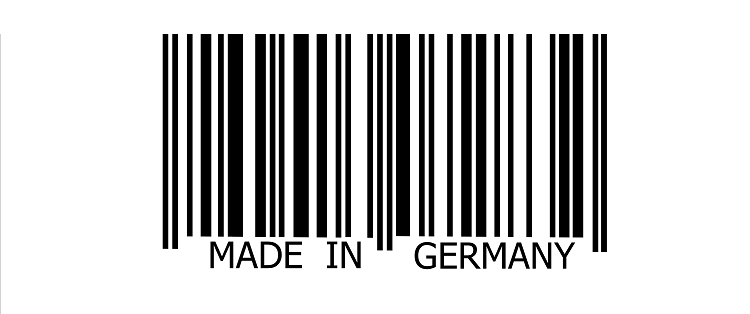 Quelle: iStock.com/flik47
Quelle: iStock.com/flik47
“Made in Germany” – why the label stands worldwide for top quality
22. June 2020 Published by Raphael Doerr“Made in Germany” is regarded worldwide as a seal of quality: Products from Germany are at the top of the list for consumers, and people from all over the world come to Germany to buy specific products. Although this image may have recently been tarnished by the diesel scandal, data from the international YouGov-Cambridge Globalism Project proves how popular Germany is as a producer.
The Made in Germany “seal” has already existed for 125 years, but it didn’t originally stand for particularly good quality. In 1887, Great Britain decided that products manufactured in Germany had to bear the label “Made in Germany”. The reason for this was that German companies were producing astonishingly authentic imitations of the high-quality knives from Sheffield in England, but in poorer quality.
However, this was soon to change: At the height of industrialization, the quality of products made in Germany rose rapidly. As a result, the erstwhile stigma became a seal of quality that spread worldwide through the country’s economic miracle after the Second World War and is symbolic to this day of “striving for top quality and precision, ambition and performance”.
Since then, “Made in Germany” has stood in particular for the following characteristics:
- A spirit of innovation and engineering ingenuity
Whether it’s Werner von Siemens, Carl Benz or Robert Bosch – innovation and technical excellence are inextricably associated with products made in Germany. From the telegraph to the automobile, numerous inventions that continue to shape our lives today were developed and produced in Germany.
- Top quality and durability
Alongside innovation, “Made in Germany” is also synonymous with the high quality of the materials used and workmanship. In addition to good workmanship, high-quality metals and plastics without planned obsolescence ensure that products provide many years of service without any loss of function.
- Top-class design
Alongside high quality, a clear design is one of the trademarks that many people associate with products made in Germany. Based on the tradition of the Bauhaus movement, straightforward design with clean lines and dispensing with unnecessary embellishment has become the esthetic core of “Made in Germany”.
Since the term was established, the economic and social conditions have changed significantly. In the course of globalization, increasingly distributed production locations and longer supply routes, “Made in Germany” has gained importance in other aspects:
- Best service and highest safety standards
By rigorously optimizing production processes and using state-of-the-art digital technologies, companies are constantly striving for maximum precision – and that can effectively be achieved locally. In other words, the service systems available in Germany can ensure permanent best quality from production to the final consumer product. That particularly concerns spare parts and any kind of repair services that are always available quickly and easily. Products “Made in Germany” therefore also meet the highest safety standards. Specifically due to the strict safety guidelines in Germany, every aspect of individual products is subject to constant monitoring by independent testing organizations.
- For the sake of the environment
If goods are produced in Germany, that protects the environment since it dispenses with long supply routes. The already increasingly strict environmental guidelines that are checked regularly by the authorities do the rest and guarantee a long service life. A positive side effect of supply routes within Germany are the short and flexible delivery times.
- Supply bottlenecks passé
Companies that produce exclusively in Germany are better protected when there are fluctuations in the global market, since there’s no risk of supply bottlenecks. These fluctuations can be financial crises, triggered by bank failures or – right now – a pandemic threat due to a virus. That ensures a high level of reliability and proactive product planning.

Germany imports more than half (55 percent) of its imported inputs from abroad, making it heavily intertwined with global economic trade. This high level of integration is unproblematic as long as global trade has not been effectively crippled by a global crisis. The last few weeks have shown that production – if possible – should be carried out in Germany. It therefore remains right and important to keep on identifying the areas in which the German economy should transfer production sites or research and development facilities abroad back to Germany.
Commitment to Germany as a business location
Gigaset, originally part of Siemens, has been an independent, listed and internationally operating manufacturer in the area of communications technology since it was carved out from Siemens in 2010.
The company stands for the transformation that telephony has gone through especially in the last ten years – and has positioned itself in the market with a business model that turns the mantra of global division of labor on its head: With a strong history shaped by innovation dating back 175 years and strong roots in Germany, where the company manufactures its products, Gigaset is the first manufacturer to produce smartphones in Germany at its site in Bocholt in the Münsterland region.
With its unique selling point of “Made in Germany”, Europe’s market leader for DECT cordless phones is also positioning itself as a manufacturer of attractive value-for-money smartphones and a holistic solution provider for the smart home segment, focusing on security, convenience, energy management, and ambient assisted living. By producing in its own country, it saves not only valuable resources and protects the environment, but also drives forward the country’s own economy.
Modern, reliable, secure and user-oriented communications solutions from a single source – whether for private or professional use: That’s what Gigaset stands for.
 Comments
Comments

 en
en 







